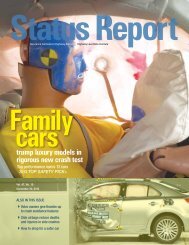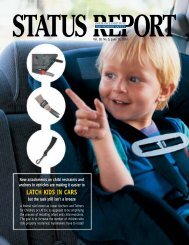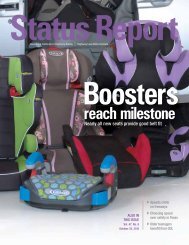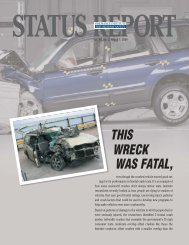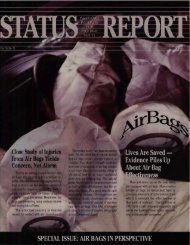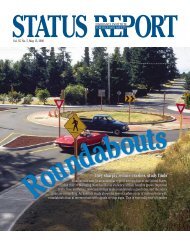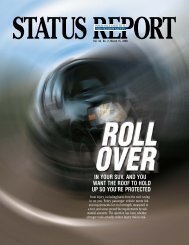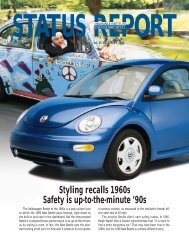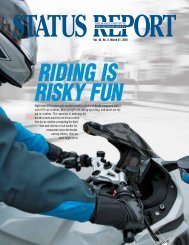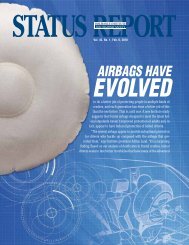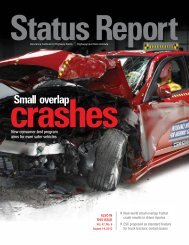IIHS Status Report newsletter, Vol. 47, No. 1, Jan. 24, 2012
IIHS Status Report newsletter, Vol. 47, No. 1, Jan. 24, 2012
IIHS Status Report newsletter, Vol. 47, No. 1, Jan. 24, 2012
You also want an ePaper? Increase the reach of your titles
YUMPU automatically turns print PDFs into web optimized ePapers that Google loves.
ANTILOCK 2015BRAKESELECTRONIC 2029STABILITYCONTROL<strong>Vol</strong>. <strong>47</strong>, <strong>No</strong>. 1, <strong>Jan</strong>. <strong>24</strong>, <strong>2012</strong>FRONTAL AIRBAGS 2016SIDE AIRBAGS 2028FORWARD COLLISIONWARNING2049ESTIMATEDTIME OFARRIVALVehicles that warn drivers of hazards, put thebrakes on for them, and keep themselves in theirlanes already are on the road. Cars that can talk toeach other are just over the horizon. Is the crashfreefuture here?<strong>No</strong>t quite. It’s true that safety features being introducednow could potentially eliminate millions ofcrashes. But even if these features were capableof preventing all crashes — and right now they’renot — they won’t be available in the vehiclesmost people drive for many years to come.A new report from the Highway Loss Data Institute(HLDI) shows that it typically takes 3 decadesfor a promising safety feature first introduced in afew luxury cars to spread through the fleet. Moreprecisely, it will take at least that long before 95percent of vehicles on the road could have a given
2 <strong>Status</strong> <strong>Report</strong>, <strong>Vol</strong>. <strong>47</strong>, <strong>No</strong>. 1, <strong>Jan</strong>. <strong>24</strong>, <strong>2012</strong>feature either because it came as standardequipment or was offered as an option. Forinstance, it won’t be until 2016 that 95 percentof all registered vehicles could have frontalairbags, the authors predict, even thoughmanufacturers began adding frontal airbags inmeaningful numbers during the mid-1980s.Forward collision warning, which was rolledout in the United States in 2000, could takeeven longer. If it continues to follow its currenttrajectory, the crash avoidance technologywon’t be available in 95 percent ofregistered vehicles until 2049, HLDI predicts.“Technology is changing fast, but it takestime for it to reach the majority of vehicles,”says Matthew Moore, an author of the reportand vice president of HLDI, an Instituteaffiliate. “New features that prove beneficialaren’t instantly available in all new models.And once they are, not everyone rushes outto replace their old vehicle right away.”Crash avoidance systems introduced inthe past few years in luxury vehicles couldcut crashes substantially. The Institute hasestimated that if all vehicles were equippedwith forward collision warning, lane departurewarning, side view assist, and adaptiveANTILOCK BRAKESAntilock brakes in their modern form were first introduced in 1985 models. Studies haven’t shown large safety benefits for the feature on passengervehicles, and NHTSA never required it. Nevertheless, antilocks spread quickly throughout the fleet. By 1990, they were standard on 17 percentof models and optional on an additional 12 percent. For the 2010 model year, they were standard on 99 percent and optional on 1 percent. HLDIpredicts antilocks will be available for 95 percent of registered vehicles by 2015.PERCENT OF NEW VEHICLE MODELS WITH ANTILOCK BRAKES80%60%40%20%n standardn optionaln not available80%60%40%20%PREDICTED PERCENTAGEOF REGISTERED VEHICLESWITH ANTILOCKS– current availability– predicted availability1985199019952000200520101985 1990 1995 2000 2005 2010 2015 2020 2025 2030FRONTAL AIRBAGSFrontal airbags came to the U.S. market in the 1984 model year, following a brief period in the 1970s when a limited number of airbag-equipped cars wereproduced. The government began requiring their installation in some vehicles in 1996, and they have been required in all new passenger vehicles exceptthe very heaviest since 1999. Still, it won’t be until 2016 that frontal airbags for drivers will be available for 95 percent of vehicles on the road.PERCENT OF NEW VEHICLE MODELS WITH FRONTAL AIRBAGS80%60%40%20%n standardn optionaln not available80%60%40%20%PREDICTED PERCENTAGEOF REGISTERED VEHICLESWITH FRONTAL AIRBAGS– current availability– predicted availability1985199019952000200520101985 1990 1995 2000 2005 2010 2015 2020 2025 2030
<strong>Status</strong> <strong>Report</strong>, <strong>Vol</strong>. <strong>47</strong>, <strong>No</strong>. 1, <strong>Jan</strong>. <strong>24</strong>, <strong>2012</strong> 3headlights, 1.9 million crashes — including1 in 3 fatal crashes — could potentially beprevented or mitigated if the systems workedperfectly (see <strong>Status</strong> <strong>Report</strong>, May 20, 2010;on the web at iihs.org). In the first real-worldstudy of one such feature, HLDI found thatclaims under property damage liability coveragewere filed about a quarter less oftenfor <strong>Vol</strong>vo XC60s equipped with City Safety, alow-speed forward collision avoidance system,than for similar SUVs without it (see<strong>Status</strong> <strong>Report</strong>, July 19, 2011).Future technology could include other potentialgame-changers. A consortium of automakersis developing vehicle-to-vehicle andvehicle-to-infrastructure communicationsplatforms that could take crash avoidanceeven further. Some manufacturers predictthese systems could appear in vehicles asearly as 2015. Meanwhile, Google has a fleet ofcars modified to operate without a driver andhas been granted a patent for the technology.To help understand how quickly new technologymight spread, HLDI looked at five existingfeatures: antilock brakes, electronicstability control (ESC), driver frontal airbags,side airbags, and forward (continues on p. 5)IT TAKES AT LEAST 30 YEARS FOR A PROMISING SAFETY FEATURETO SPREAD T0 95 PERCENT OF VEHICLES ON THE ROAD. SOMEDRIVERS RARELY REPLACE THEIR VEHICLES, SO CHANGES TONEW MODELS DON’T REACH THE ENTIRE FLEET FOR DECADES.
<strong>Status</strong> <strong>Report</strong>, <strong>Vol</strong>. <strong>47</strong>, <strong>No</strong>. 1, <strong>Jan</strong>. <strong>24</strong>, <strong>2012</strong> 5(continued from p. 3) collision warning. All of them come with differentexpectations of potential safety benefits. Some are required bythe National Highway Traffic Safety Administration, and some aren’t.Researchers used HLDI data on the availability of features ineach model and registration data from R.L. Polk & Co. If a featurewas either standard or optional, it was considered available. Futureavailability was predicted by extrapolating the historicaltrends in the registration data. The researchers assumed that thenumber of new vehicles added each year and the attrition rate ofolder vehicles would stay the same.Although the report projects availability in 100 percent of the fleet,safety features never become universal in the real world. Collectorsown and drive classic vehicles, and some people keep very old carsfor sentimental reasons. Leaving aside such holdouts, it would take aminimum of <strong>24</strong> years for the fleet to completely turn over under currentconditions of approximately <strong>24</strong>0 million registered passenger vehiclesand about 10 million new vehicles registered a year. In reality, ittakes longer because not every new vehicle replaces one of the oldest.Despite very different histories, all the features in the reporttake about the same time from the moment they’re first introducedto the point when they’re available in 95 percent of registered vehicles.Other than forward collision warning, which is still in itsearly stages, the most gradual spread is for ESC (34 years). Thefastest moving features are head-protecting side airbags and antilockbrakes (31 years). These estimates only reflect the maximumpercentage of vehicles that could have a feature. The actual percentagethat have it would be lower, since for some vehicles thetechnology would have been offered only as an option.The path each feature takes on the way to 95 percent variessomewhat. Head-protecting side airbags, for example, shot upquickly in the beginning. It took 10 years for them to be available in25 percent of the registered fleet, and it’s expected to take 15 yearsto reach 50 percent. In contrast, ESC reached the one-quarter markafter 16 years and is expected to be in half the fleet after 20 years.It takes a decade or more for a feature to go from 95 percentavailability in the fleet to just shy of 100 percent, thanks to thesmall percentage of drivers who rarely replace their vehicles.Federal mandates, safety ratings that reward certain features,and other factors can speed up the rate at which technology endsup in new models and therefore in registered vehicles. For example,if all new vehicles were equipped with forward collision warningstarting in 2013, it would take until 2034 instead of 2049 for 95percent of vehicles to have been sold with that feature available.Interestingly, antilock brakes have spread quickly even though theywere never required. Despite promising results on the test track, realworldcrash data haven’t shown large benefits from the technology.“Antilocks quickly went mainstream when General Motors madethem standard on some big-selling models,” Moore says. “They gotanother boost from ESC because an antilock braking system is a prerequisitefor stability control. <strong>No</strong>w that the government requires ESCon new vehicles, antilocks have essentially become mandatory, too.”
6 <strong>Status</strong> <strong>Report</strong>, <strong>Vol</strong>. <strong>47</strong>, <strong>No</strong>. 1, <strong>Jan</strong>. <strong>24</strong>, <strong>2012</strong>NEW BUMPER TESTSSHOW EASY FIX FORMISMATCH PROBLEMThe problem of mismatched bumpers oncars and SUVs could be solved with somesimple modifications, saving consumers thousandsof dollars on repairs after low-speedcollisions, Institute tests show.In 2010, a series of low-speed tests involvingSUVs and cars highlighted the expensivedamage that results when bumpers don’tline up (see <strong>Status</strong> <strong>Report</strong>, Dec. 2, 2010; onthe web at iihs.org). Seven pairs of cars andSUVs from the same manufacturers werecrashed into each other. Damage to bothvehicles in each of the 10 mph collisionsranged from about $3,000 to nearly $10,000.<strong>No</strong>w the Institute has teamed up withTech-Cor, Allstate’s auto-repair research center,to show how lowering SUV bumpers afew inches can reduce crash damage. Engineerspicked 2 of the previously tested SUVsand modified their bumpers. The crasheswere then repeated, resulting in big reducdardrequires cars to have bumpers that provideprotection over a zone 16 to 20 inchesoff the ground. There are no such requirementsfor SUVs, pickups, or minivans. As aresult, some of them have flimsy bumpers,and many others have bumpers much higheroff the ground than those of cars.The result is high repair costs for evenminor crashes. When bumpers work asintended, they absorb most of the energyin a low-speed crash. When they don’tline up, the vehicle body bears the bruntof the crash energy. Damage to headlights,grilles, radiators, and other partsadds up to big bills.In the 2010 tests, the crash of the Focusinto the Escape resulted in one of the highestdamage totals. The lower edge of theEscape’s rear bumper is 23 inches off theground — the highest of all the SUVs tested— and the Focus’ front bumper missed it bymore than an inch. The result was that theFocus went under the Escape and ended upneeding a new hood, headlights, air-conditioningcondenser, and other parts for a totalof $5,203. The Escape wasn’t unscathed,either, with $2,208 worth of damage.$4,000SUV/CAR TEST DAMAGE WITH ORIGINALEQUIPMENT AND LOWERED SUV BUMPERSn original SUV bumpern modified SUV bumper$2,000Ford Focus (front) Ford Escape (rear) Jeep Patriot (front) Dodge Caliber (rear)Crash damage before modifications in repair costs for both cars. In thecase of a Ford Focus that was crashed intothe back of a Ford Escape, the damage plummeted84 percent to less than $1,000 afterthe Escape’s rear bumper was lowered.Bumpers generally consist of a reinforcementbar under a plastic cover. When itcomes to limiting crash damage, it’s what’shidden under the plastic that counts, andsometimes there isn’t much. A federal stan-Improving the placement of the Escape’srear bumper was straightforward. Tech-Corengineers added bumper brackets from anotherSUV to the existing rear frame, then attachedthe bumper bar, bringing it down 3 ½inches from its original location. When thevehicles were crashed again, the only damageto the Focus was to the bumper coverand grille — an $853 repair job. The damageto the Escape fell slightly as well, to $2,070.Crash damage after modifica
<strong>Status</strong> <strong>Report</strong>, <strong>Vol</strong>. <strong>47</strong>, <strong>No</strong>. 1, <strong>Jan</strong>. <strong>24</strong>, <strong>2012</strong> 7tiontionThe other SUV selected formodification was the Jeep Patriot,which had inflicted $3,095 worth ofdamage on the Dodge Caliber when itcrashed into the Caliber’s rear. Since the2 vehicles share a platform, engineers wereable to simply bolt the front bumper of a Caliberonto the Patriot. This lowered the SUV’s bumpernearly 3 inches. The Patriot’s new front bumper and theCaliber’s rear bumper overlapped more than 3 ½ inches, comparedwith less than an inch of overlap for the original equipment.Damage to the Caliber fell 40 percent to $1,8<strong>47</strong>, and the changeshaved $34 off the Patriot’s $1,415 repair bill.For both SUVs, the lower bumpers fit under the original covers,so the modified vehicles didn’t look any different. <strong>No</strong>r was thereany change in approach or departure angles that could affect avehicle’s usefulness off-road and at loading ramps.“This experiment shows just how easy it would be to designSUVs with effective bumpers,” says Joe <strong>No</strong>lan, the Institute’s chiefadministrative officer. “By making simple tweaks, manufacturerscould help consumers save on repairs and insurance premiumswithout compromising on styling or function.”FINAL HOURS-OF-SERVICE RULELEAVES 11-HOUR SHIFT INTACTTruck drivers can continue to spend as many as 11 hours a day onthe road under a final hours-of-service rule the Federal Motor CarrierSafety Administration (FMCSA) issued in December. The agencyhad proposed shortening the daily allowable driving time but said“compelling scientific evidence” is needed to support the move.Other tenets of the rule are in line with the agency’s 2010 noticeof proposed rulemaking (see <strong>Status</strong> <strong>Report</strong>, April 26, 2011; on theweb at iihs.org). Commercial carriers must comply by July 2013.Hours-of-service regulations are intended to help alleviate fatigueby regulating drive and rest times. The new rule limits use of the socalledrestart provision that permits truckers to begin a new workweekafter 34 hours off duty. Restarts will be restricted to 1 every 7days, or 168 hours, compared with the 2 restarts now allowed. Driverswho use them will have to get at least 2 nights’ rest from 1 to 5 a.m.While the rule reduces the hours truckers can work in a week, itstill allows them to spend more time on the road in a day than theycould before FMCSA changed hours-of-service rules in 2003 (see<strong>Status</strong> <strong>Report</strong>, June 16, 2003). Previously truckers had been held to10 hours of driving a day.FMCSA said it determined that the economic benefits of the current11-hour maximum trump the safety gains associated with limitingtruckers to 10 hours on the road.“There is solid scientific evidence to support restoring the 10-hour daily driving limit,” said Anne McCartt, the Institute’s seniorvice president for research. “Numerous studies show that crashrisk increases long before 11 hours of driving. We hope the agencywill reconsider its decision.”A federal appeals court has twice overturned prior hours-of-servicerules in response to lawsuits filed by Advocates for Highwayand Auto Safety, Public Citizen, the International Brotherhood ofTeamsters, and others. The latest rule grew out of the agency’s 2009settlement with these groups (see <strong>Status</strong> <strong>Report</strong>, June 19, 2010).“By keeping the unsafe portion of the rule that permits truckersto drive for 11 consecutive hours, department officials have brokentheir promise to make safety their <strong>No</strong>. 1 priority,” said Henry Jasny,vice president and general counsel of Advocates for Highway andAuto Safety. The group “is confident that the court will reach thesame result when this new rule comes before it for judgment.”The American Trucking Associations, which lobbied to retaincurrent regulations, opposes the new provision requiring driversto rest during overnight hours as part of a 34-hour restart.“This rule will put more truck traffic onto roadways during morningrush hour, frustrate other motorists, and increase the risk ofcrashes,” said Bill Graves, the group’s president and chief executive.FMCSA said the overnight periods are in keeping with circadiansleep patterns and will help drivers get better quality rest.
1005 N. Glebe Rd., Arlington, VA 22201Phone 703/2<strong>47</strong>-1500 Fax 2<strong>47</strong>-1588Internet: www.iihs.org<strong>Vol</strong>. <strong>47</strong>, <strong>No</strong>. 1, <strong>Jan</strong>. <strong>24</strong>, <strong>2012</strong>New safety features take 3 decadeson average to spread through the vehiclefleet, a HLDI report says ...........1Bumper demonstration test showseasy way to solve mismatch problemwhen SUVs and cars collide ..............6Final hours-of-service rule still allowstruck drivers to spend up to 11hours a day at the wheel ....................7Copy may be republished with attribution.Images require permission to use.The Insurance Institute for Highway Safety is anonprofit scientific and educational organizationdedicated to reducing deaths, injuries, and propertydamage from crashes on the nation’s highways.The Institute is wholly supported by auto insurers:AAA <strong>No</strong>rthern California, Nevada, and UtahACE Private Risk ServicesAffirmative InsuranceAgency Insurance Company of MarylandAlfa Alliance Insurance CorporationAlfa InsuranceAllstate Insurance GroupAmerican Family Mutual InsuranceAmerican National Property and Casualty CompanyAmeriprise Auto & HomeAmica Mutual Insurance CompanyARI Insurance CompaniesAuto Club EnterprisesAuto Club GroupBankers Insurance GroupBituminous Insurance CompaniesCalifornia Casualty GroupCapital Insurance GroupChubb & SonColorado Farm Bureau Mutual Insurance CompanyConcord Group Insurance CompaniesCotton States InsuranceCOUNTRY FinancialDirect General CorporationDiscovery Insurance CompanyErie Insurance GroupEsuranceFarm Bureau Financial ServicesFarm Bureau Insurance of MichiganFarm Bureau Mutual Insurance Company of IdahoFarmers Insurance Group of CompaniesFarmers Mutual Hail Insurance Company of IowaFarmers Mutual of NebraskaFireman’s Fund Insurance CompanyFirst Acceptance CorporationFlorida Farm Bureau Insurance CompaniesFrankenmuth InsuranceGainsco InsuranceGEICO GroupGeorgia Farm Bureau Mutual Insurance CompanyGMAC Personal Lines InsuranceGrange InsuranceHallmark Insurance CompanyHanover Insurance GroupThe HartfordHaulers Insurance Company, Inc.Homeowners of America Insurance CompanyHorace Mann Insurance CompaniesICW GroupImperial Fire & Casualty Insurance CompanyInfinity Property & CasualtyKemper PreferredKentucky Farm Bureau InsuranceLiberty Mutual Insurance CompanyLouisiana Farm Bureau Mutual Insurance CompanyMaryland Automobile Insurance FundMercury Insurance GroupMetLife Auto & HomeMiddleOakMississippi Farm Bureau Casualty Insurance CompanyMMG InsuranceMutual of Enumclaw Insurance CompanyNationwideNew Jersey Manufacturers Insurance GroupNLC Insurance Companies, Inc.<strong>No</strong>dak Mutual Insurance Company<strong>No</strong>rfolk & Dedham Group<strong>No</strong>rth Carolina Farm Bureau Mutual Insurance Company<strong>No</strong>rthern Neck Insurance CompanyOld American County Mutual Fire InsuranceOregon Mutual InsurancePekin InsurancePEMCO InsurancePlymouth Rock AssuranceProgressive CorporationThe Responsive Auto Insurance CompanyRockingham GroupSafeco InsuranceSamsung Fire & Marine Insurance CompanySECURA InsuranceSentry InsuranceShelter InsuranceSompo Japan Insurance Company of AmericaSouth Carolina Farm Bureau Mutual Insurance CompanySouthern Farm Bureau Casualty Insurance CompanyState Auto Insurance CompaniesState FarmTennessee Farmers Mutual Insurance CompanyTexas Farm Bureau Insurance CompaniesTower Group CompaniesThe Travelers CompaniesUnited EducatorsUSAAViceroy Insurance CompanyVirginia Farm Bureau Mutual InsuranceWest Bend Mutual Insurance CompanyYoung America Insurance CompanyZurich <strong>No</strong>rth AmericaFUNDING ASSOCIATIONSAmerican Insurance AssociationNational Association of Mutual Insurance CompaniesProperty Casualty Insurers Association of America



